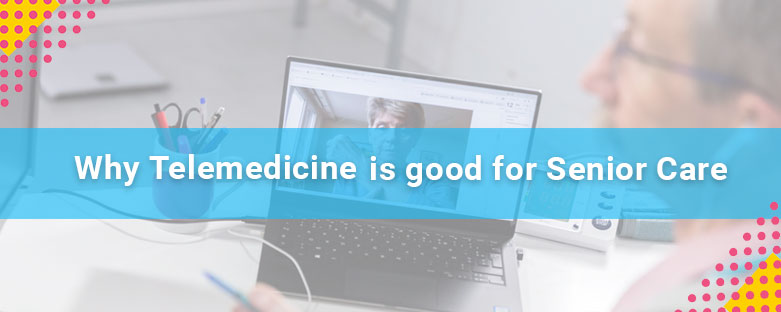Why Telemedicine is good for Elderly Care
Telemedicine is good for elderly care because it is medical treatment delivered using technology that decreases the time that patients have to spend in personal care at the doctor’s office or the hospital.
It involves talking to physicians over the phone or with video conferencing technology and using remote monitoring technology to track vital signs until they become an issue and identify health warning signs.
Some forms of diseases or accidents also require trips to the doctor’s office, but there is a wide variety of health care needs that can be treated instead of in-person visits via telemedicine.
Efficient Telemedicine for Older Adults offers more access to medical services for older adults than in-person visits. Yet telemedicine for elderly patients is also daunting to use these technologies.
The risk of the COVID-19 pandemic for seniors providing in-home elder care has increased. To improve the safety of home visits, caregivers use masks, hand wash, social distance, but for many, decreasing the frequency of visits can be a valuable piece of the pandemic safety protocol puzzle.
The telemedicine service provider may meet a percentage of service needs, while dramatically reducing both cost and transmission risk, particularly for seniors eligible for lower-level Home Care packages. Innovative telemedicine software development is the way to provide socially remote, high-quality care for many home care caregivers.
Being an aged senior means that, you also need to go to the doctor more often than ever. Some days it can feel like all you do for another appointment is go their way. When you can drive, regular medical appointments can be obnoxious enough, but if your loved ones take away the keys, it becomes so much more difficult to figure out how to get to the doctor’s office each time you need to.
Telemedicine app development does not just offer ease; it offers a range of significant advantages that any senior should be excited about:
it’s a new twist on the house call when patients can stay in a quiet, familiar atmosphere, without coping with the tension and anxiety that often surrounds a senior’s commute to the doctor’s office, they can concentrate on exchanging information useful for their treatment.
1. Telemedicine Patient-centred Care Is Priority
Telemedicine is a one-on-one consultation in which the patient may feel more comfortable asking questions or discussing a care plan’s steps. This telemedicine setup is better than attempting to relay information to your doctor or nurse and then make them relay the message. Your sound of cough can hear the specialist or see your swollen eyes. You will learn about your condition and treatment choices firsthand.
2. It Is Safe And Secure For Elderly Care
Telemedicine providers are legally bound to comply with the mandates of the Health Insurance Portability and Transparency Act, U.S. Explanation for News & World Report. In a move to improve privacy and minimize fraud, HIPAA specifically concerns the safety of patient medical records. Telemedicine is also a convenient and reliable approach to medicine, reducing the increased burden for seniors and caregivers.
3. You Get Access To Experts Worldwide For Elderly Care
Finding the right physician with experience in treating a medical illness may be a challenge for seniors living in rural areas. With telemedicine, in Blackfoot, Idaho, the leading nephrologist in Boston will provide real-time treatment for your loved one. In return, doctors can broaden their patient base, obtain helpful health information from other countries, and compete in the field against larger healthcare systems.
4. Speed Up Workplace Workflows for Elderly Care
Your doctor’s office also benefits from current innovations that streamline office processes by incorporating software systems that enable telemedicine capabilities. This implies that the electronic medical record of a patient is confidential and readily available by doctors and care coordinators.
Is Telemedicine the Future of Health Care for Elderly Care?
Remote care for seniors helps paramedics to continuously monitor the key life parameters of a patient and to communicate with a general practitioner, physiotherapist, dietitian, psychologist, or other medical professionals about their state of health and well-being in their later years.
But we know that everyone does not have smartphones and some people don’t know how to use a smartphone. These kinds of problems are listed below:
1. Barriers to Access
The first challenge is the ability to have enough access to Wi-Fi or wireless data so that you can have a visit and have a video visit beyond a telephone call. There is inadequate access for between 25 per cent and 40 per cent of the population. They are not technologically comfortable for many older patients, so that is another obstacle.
2. Lack of awareness
The biggest obstacle in telemedicine is the lack of awareness among the patients. If telemedicine is not known to patients, it will not be used. Most people also have no idea that via telemedicine they have an opportunity to talk or chat with providers.
3. Lack of Technical knowledge of patients
It can decrease usage and hamper accessibility if patients do not understand how to use telemedicine services. Before launching your telemedicine services, it’s a good idea to interview patients and ask which devices they will be most comfortable using while accessing your telemedicine services.
Training your workers to use your telemedicine equipment is equally critical, so they can also assist patients who need assistance.
4. Needs learning assistance with the use of mobile devices and digital services
They will also need support to adjust to new behaviour by using gadgets and digital technologies, aside from the physical and health-related variables that impede the success of seniors using technology.
5. Individuals with physical constraints
Older adults with dementia (14 per cent of those aged 71 and older), hearing loss (almost two-thirds of those aged 70 and older), and vision deficiency (13.5 per cent of those aged 65 and older) may have trouble using interactive technologies and services that are among them.
6. Limited financial resources
Often, many older adults with minimal financial resources may not be able to afford devices or Internet service charges linked to them. (Half of the seniors live alone and 23% are unable to afford basic needs in two-person households.) Others are not adept at using technology and lack the help to understand.




